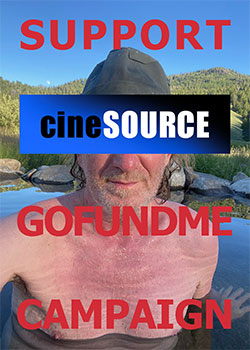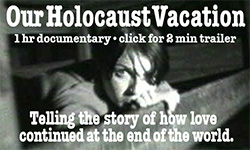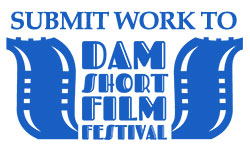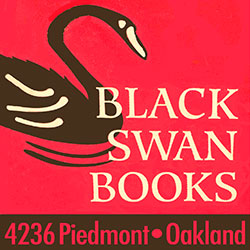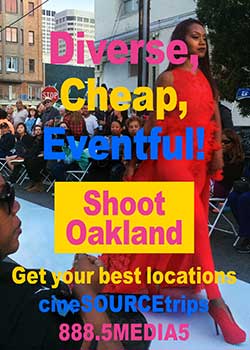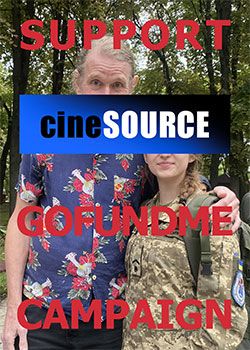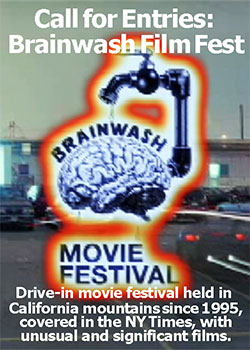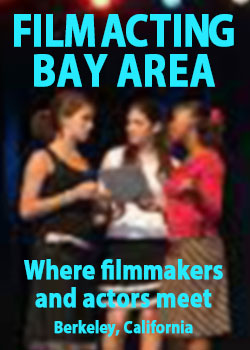Albert Maysles
by David L. Brown
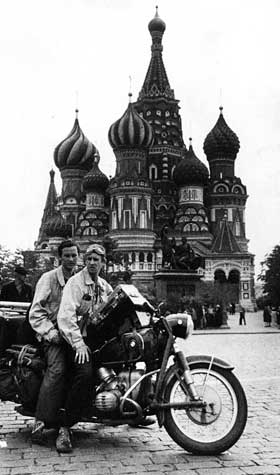 In early April, I drove up to Oregon to attend the Ashland Independent Film Festival (AIFF) with my wife and co-producer, Jane Kinzler. Traveling with us was acclaimed Bay Area filmmaker, Les Blank. During a conversation about Les’ documentary-in-progress on Direct Cinema pioneer Richard Leacock, he mentioned a plan to interview Leacock’s long-time filmmaking partner, D.A. Pennebaker. Remembering that Leacock worked closely for years with Albert Maysles, who was being honored in Ashland with a Lifetime Achievement Award, I suggested wrangling a camera to interview Albert. Les and Jane agreed that it was an inspired idea.
In early April, I drove up to Oregon to attend the Ashland Independent Film Festival (AIFF) with my wife and co-producer, Jane Kinzler. Traveling with us was acclaimed Bay Area filmmaker, Les Blank. During a conversation about Les’ documentary-in-progress on Direct Cinema pioneer Richard Leacock, he mentioned a plan to interview Leacock’s long-time filmmaking partner, D.A. Pennebaker. Remembering that Leacock worked closely for years with Albert Maysles, who was being honored in Ashland with a Lifetime Achievement Award, I suggested wrangling a camera to interview Albert. Les and Jane agreed that it was an inspired idea.
Arriving in Ashland, we soon had local filmmakers with video gear from the helpful festival staff. Joanne Feinberg, the festival’s lead programmer and a former Bay Area editor, arranged the interview. The 81-year-old filmmaker was quite willing, even after a long day of screenings and tributes, to be part of a Les Blank film on his old friend Ricky Leacock. The next morning, the festival showed The Gates, an entertaining, beautifully-crafted Maysles Brothers film about Christo’s 2005 art installation in Central Park. Outside the theater afterward, Al’s artist/filmmaker son, Philip, was filming his dad interacting with friends and fans for Al’s own autobiographical film. This began two glorious days of unforgettable privileged access with one of the great documentary cameramen of all time – a true pioneer of observational filmmaking – Direct Cinema.
Both Les and I were quite aware of Al’s and Ricky’s key roles in the genesis of Direct Cinema. In late 1959, brothers Albert and David Maysles were invited to join Leacock and Pennebaker in Robert Drew Associates, a documentary unit at Time-Life. RDA was in the process of revolutionizing the documentary form by engineering smaller, lighter, quieter 16mm cameras with crystal sync to replace the sync cable. These cameras, together with the first small Nagra audio tape recorders and faster black-and-white film stock, enabled filmmakers for the first time to be truly mobile while shooting sync sound – meaning they could shoot on the run virtually anywhere. The French school of cinema verité, lead by Jean Rouch, used the new equipment with equal zeal. This revolution was probably more important than the digital video revolution of 1995.
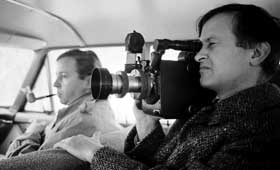 Maysles’ gracious storytelling was tremendously exciting for Les, Jane and me, as well as to a dozen or so other filmmakers gathered around. When we finished, Al agreed to schedule an interview after the Sunday screening of Grey Gardens. So Saturday night’s Handheld from the Heart, his self-portrait talk (with clips from his 50-year career), was a fascinating teaser. The program included extraordinary clips and commentary beginning, with Al’s first film, Psychiatry in Russia (1955). Then came the Maysles Brothers films: What’s Happening! The Beatles in the US (When the call came, Al asked David: “Who are the Beatles?” David responded, “They’re good. Let’s do the shoot.”); Primary with Leacock and Pennebaker, the first Direct Cinema doc (with the celebrated 70-second hand-held tracking shot of JFK); Yanqui No!, also with Drew Associates on Castro’s Cuba in 1960 (Al: “I got off the plane, got into a cab, and said to the cab driver: ‘Where’s Fidel.’ He said, ‘He’s talking to a woman’s group in this big auditorium.’ I said, ‘Take me there.’”); Meet Marlon Brando (interview after interview with Brando, acceptable to Direct Cinema-makers as long as the filmmaker was not doing the interview. “Interviews are the easy way,” said Al); the classic Salesman (Norman Mailer said, “I can’t think of many movies which have had as much to say about American life and have said it so well.”); Gimme Shelter, Grey Gardens (first a cult classic, then a Broadway musical and now a Hollywood movie with Jessica Lange and Drew Barrymore), Running Fence, Vladimir Horowitz, and Lalee’s Kin.
Maysles’ gracious storytelling was tremendously exciting for Les, Jane and me, as well as to a dozen or so other filmmakers gathered around. When we finished, Al agreed to schedule an interview after the Sunday screening of Grey Gardens. So Saturday night’s Handheld from the Heart, his self-portrait talk (with clips from his 50-year career), was a fascinating teaser. The program included extraordinary clips and commentary beginning, with Al’s first film, Psychiatry in Russia (1955). Then came the Maysles Brothers films: What’s Happening! The Beatles in the US (When the call came, Al asked David: “Who are the Beatles?” David responded, “They’re good. Let’s do the shoot.”); Primary with Leacock and Pennebaker, the first Direct Cinema doc (with the celebrated 70-second hand-held tracking shot of JFK); Yanqui No!, also with Drew Associates on Castro’s Cuba in 1960 (Al: “I got off the plane, got into a cab, and said to the cab driver: ‘Where’s Fidel.’ He said, ‘He’s talking to a woman’s group in this big auditorium.’ I said, ‘Take me there.’”); Meet Marlon Brando (interview after interview with Brando, acceptable to Direct Cinema-makers as long as the filmmaker was not doing the interview. “Interviews are the easy way,” said Al); the classic Salesman (Norman Mailer said, “I can’t think of many movies which have had as much to say about American life and have said it so well.”); Gimme Shelter, Grey Gardens (first a cult classic, then a Broadway musical and now a Hollywood movie with Jessica Lange and Drew Barrymore), Running Fence, Vladimir Horowitz, and Lalee’s Kin.
Albert’s eloquent and heartfelt recounting included the statement that love and empathy are the key concepts in his style of documentary-making. He summed up the soulful humanism at the heart of Al Maysles’ filmmaking: “Empathy is seen in the eyes, and offers the filmmaker power to reach hidden truths. As a documentarian, I happily place my faith in reality. It is my caretaker, the provider of subjects, themes, experiences – all endowed with the power of truth and the romance of discovery. And the closer I adhere to reality, the more honest and authentic my tales. After all, the knowledge of the real world is exactly what we need to better understand – and therefore possibly to love one another. It is my way of making the world a better place.”
For our interview, San Francisco filmmaker/ DP Emiko Omori, who had brought her video camcorder to Ashland, offered to shoot second camera. So the legendary, gracious Albert Maysles granted another full day of privileged access to Emiko, Les, Jane and myself.
The two-hour interview was shot with two cameras: I was using Philip’s DVX-100b and Emiko Omori shot with her DVX-100a. Al was eloquent and forthcoming with lively, insightful stories. Les recalls, “Albert really seemed to enjoy the process of recalling the early days of Direct Cinema and his collaboration with Ricky Leacock. His eyes would light up in delight in many of the memories. His sense of joy in life and in the truthtelling power of documentary is strikingly similar to Ricky’s.”
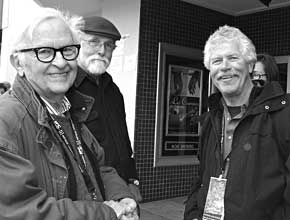 Al explained that the famous long tracking shot in Primary was done by holding the camera over his head with a wide-angle lens right behind JFK. The shot – which was Pennebaker’s idea – was included in the first ever Direct Cinema documentary, and became the most significant and influential hand-held shot in the early sixties. Jackie Kennedy loved Al’s shot of her gloved fingers nervously fidgeting behind her back. Al described the film as revealing “a kind of truth that came on the cinema screen that no one had every seen before. It was so exciting to watch. All of us were so determined to create this new kind of filmmaking.”
Al explained that the famous long tracking shot in Primary was done by holding the camera over his head with a wide-angle lens right behind JFK. The shot – which was Pennebaker’s idea – was included in the first ever Direct Cinema documentary, and became the most significant and influential hand-held shot in the early sixties. Jackie Kennedy loved Al’s shot of her gloved fingers nervously fidgeting behind her back. Al described the film as revealing “a kind of truth that came on the cinema screen that no one had every seen before. It was so exciting to watch. All of us were so determined to create this new kind of filmmaking.”
Al addressed the touchy accusations of exploitation that he and David received over their portrait of the two colorful women in Grey Gardens. Can you be exploiting them if the women love the film? Critics said yes, if the women are crazy enough. Al quoted Little Edie defending the film when, after the first screening, she announced, “The Maysles have created a classic!”
Al on Ricky Leacock: “Ricky is one of a kind, and very kind and fair. I trust him behind the camera, totally, just as many people have trusted him – although they were strangers to him, they could sense something about this guy that was trustworthy. It’s not ‘fly-on-the-wall.’ You have to establish a relationship with the people you’re filming. It doesn’t have to take hours or days. You can establish that relationship almost in a flash, sort of love at first sight, if you will. There’s something in your eyes, whether its mine or Ricky’s or whoever, that the subject picks up on as a way of either trusting or distrusting you, and if your eyes show an attitude of openness and respect and confidence, the subject picks up on that and says, ‘Let’s go.’”
On helping Pennebaker and Leacock shoot Monterey Pop: “Monterey was a great experience. I’ll always remember Ravi Shankar. There’s nothing like filming good people doing good things. Ricky always remarks that ‘Al was busy filming all the pretty girls.’ I certainly did that, but I also shot a lot of other great material, too.”
On working at Drew Associates: “There was no competition. It was totally a friendly and cooperative atmosphere, everyone working together to make this new kind of film.”
We all shared a distinct sense of privilege – as Al and David must have felt spending weeks of 24/7 days with the Beatles and the Stones – in having such access to such a font of humanistic filmmaking stories. About meeting Albert Maysles, Emiko Omori says, “He is one of my doc gods – it was electrifying. Here was a man who had recorded many of the icons of the 20th century. He wears his fame with grace, humility, and generosity. At 81, he has a million projects going on and a million ideas for more. Now that’s a role model to emulate. Thank you, Albert, for being who you are and for sharing a part of your life, your wisdom, and your vision with us.”
And Les says, “I felt very glad and privileged to be in his presence, to hear his ideas about life and the power of documentary to enrich and lift the human spirit.”
Despite the killing of a gun-wielding fan and the Hell’s Angels’ brutality captured in Gimme Shelter, Maysles Brothers films celebrate the positive sides of the human spirit rather than seeking to expose the negative. While discussing Gimme Shelter, I shared the story from my friend, DP Stephen Lighthill, who was a stage cameraman at the infamous Stones concert at Altamont (along with helping shoot Running Fence). Stephen described a sizeable group of quivering, terrified people hiding under the stage suffering from bad acid trips as “a lower level of Dante’s Inferno.” While discussing the “end of the Love Decade and the Woodstock generation,” Al spoke of the unforgettable shot of the wildly-stoned audience member being eyed with seething malice by a Hell’s Angel holding a pool cue (Al said he was sure it was his shot but acknowledged that both Stephen Lighthill and Joan Churchill were equally sure the shot was theirs – another cameraman at Altamont, George Lucas, has not to this point claimed the shot).
Les asked Al about working on the new Scorsese Rolling Stones film, Shine a Light. Al explained that “Marty asked me to shoot all the behind-the-scenes footage before and after the two concerts.” The two concerts were shot with 18 35-mm cameras on cranes, jib arms, dollies or Steadicam rigs. Al’s behind-the-scenes footage (shot in mini-DV) has been singled out by several reviewers, including Anthony Lake in The New Yorker, as the most interesting in the film. (“Running around hand-holding for long days at age 81,“ Les remarked, “that’s truly inspiring.”) Separate from the other 18 camera credits was affectionate notation: “Albert Maysles – Camera-In-Hand.”
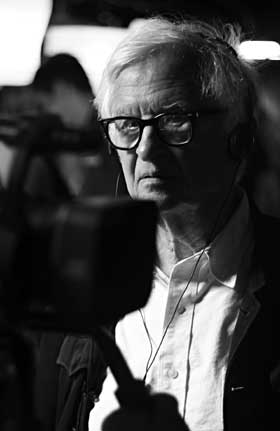 All the documentary filmmakers who saw Al at Ashland were inspired by the Maysles Brothers’ docs throughout their careers, and were very grateful for the opportunity to meet and talk with Al. Gary Weimberg, whose film Soldiers of Conscience was in the AIFF, commented, “Meeting Albert Maysles is like meeting Abraham Lincoln. He isn’t the founder of the documentary craft, but he certainly can be seen as the great emancipator of it. His work (along with his brother and the other innovators at Drew Associates) opened our eyes to the purity of observational documentaries – letting the camera do the watching, talking, and telling. Al said the one word that described best what a documentarian needed to do this work was ‘love’. And when he said that, goose bumps went up and down my spine. You could hear that he meant it. In his films, in his speech to audiences, to his chatting with us on the sidewalk, you could hear in every word his respect and affection for people, and for the rich variety of human experience itself. He had the smile of an 81-year-old elf, twinkling and energetic. As he told us stories from his career, it gave me a sense of pride to be part of this field, to practice this craft, to call myself one of those inspired by his work.”
All the documentary filmmakers who saw Al at Ashland were inspired by the Maysles Brothers’ docs throughout their careers, and were very grateful for the opportunity to meet and talk with Al. Gary Weimberg, whose film Soldiers of Conscience was in the AIFF, commented, “Meeting Albert Maysles is like meeting Abraham Lincoln. He isn’t the founder of the documentary craft, but he certainly can be seen as the great emancipator of it. His work (along with his brother and the other innovators at Drew Associates) opened our eyes to the purity of observational documentaries – letting the camera do the watching, talking, and telling. Al said the one word that described best what a documentarian needed to do this work was ‘love’. And when he said that, goose bumps went up and down my spine. You could hear that he meant it. In his films, in his speech to audiences, to his chatting with us on the sidewalk, you could hear in every word his respect and affection for people, and for the rich variety of human experience itself. He had the smile of an 81-year-old elf, twinkling and energetic. As he told us stories from his career, it gave me a sense of pride to be part of this field, to practice this craft, to call myself one of those inspired by his work.”
One of the highpoints of the interview with Al came when Les ran out of questions and, tossing to me, said: “David?” Startled but smiling, Al lit up brightly and asked if Les were seeking to channel his brother, David. Al said he missed his brother very much after David’s death in 1987, but he knew David would insist that Al continue making docs with others recording sound. Al showed a precious clip of the two strikingly-handsome brothers riding a large, heavily-laden motorcycle as they arrived in Red Square, Moscow in the late 50s.
After the interview, Emiko, Jane and I hung out with Al in the festival hospitality suite as a steady stream of filmmakers stopped by to spend a moment with Al. After a couple of riveting hours, during which Al discussed many of his photos in his new book, Maysles Scrapbook, we left Al alone to rest before his screening of Gimme Shelter. As we were leaving, we saw that he simply moved to another seating area to continue chatting with other filmmakers.
The Ashland Independent Film Festival was the perfect festival to honor Albert Maysles, while offering younger filmmakers the opportunity to meet and question him informally. Les Blank had been the honored recipient of the 2007 Artistic Achievement Award at AIFF, an award similar to Al’s Lifetime Achievement Award. As part of the tribute, last year’s fest showed Les’ new film, All in This Tea (co-produced with Gina Leibrecht), Burden of Dreams, Gap-Toothed Women, and Garlic Is As Good as Ten Mothers. Werner Herzog sent a DVD message of congratulations from Germany. Les was also a documentary juror in this year’s AIFF, judging the excellent crop of 26 nominated docs. They included six from the Bay Area: Soldiers of Conscience by Gary Weinberg and Catherine Ryan; Passion and Power by Emiko Omori and Wendy Blair; Row Hard, No Excuses by Luke Wolbach; La Corona (Oscar nominee) by Amanda Micheli; 7,500 Miles to Redemption by Tinh Mahoney and Emiko Omori; and my doc, Of Wind and Waves: The Life of Woody Brown. The juror’s choice for Best Feature Doc was Please Vote for Me, a Chinese doc on an experiment in democracy – a timely film with the Chinese Olympics coming and the Bay Area Torch protests just cooling down. It’s an excellent film that – surprise! – will not be screening openly in China.
AIFF is one of the most filmmaker-friendly festivals I’ve attended (along with Mountainfilm in Telluride). Ashland is a beautiful, sophisticated and cultured small town with dozens of gourmet restaurants, fine shops, and music clubs. Everyone involved – the festival staff, board, and volunteers – were all incredibly warm, gracious, and helpful. Everyone made a great effort to help the filmmakers feel special, and the events and programming were top-of-the line. I was very pleased to have my film screened in such exalted company. I send special kudos to two delightful women: lead programmer Joanne Feinberg, and filmmaker liaison Laura Fenneman. I am grateful to all for an extremely uplifting and special festival experience. I know I’ll be making better documentaries after spending time with Al, and I’ll try to become a better, more caring and more empathetic person and filmmaker.
Brisbane filmmaker David L. Brown has been producing and directing documentaries for 35 years including The Bridge So Far – A Suspense Story, (winner two regional Emmys), Amazing: The Rebuilding of the MacArthur Maze (2008 Emmy nomination Best Animation), and Of Wind and Waves: The Life of Woody Brown (2008 Emmy nomination Best Documentary). He currently teaches filmmaking at SF City College and UC Berkeley Extension.For more info see http://www.DLBfilms.com.
Posted on May 02, 2008 - 09:03 PM
by David L. Brown
 In early April, I drove up to Oregon to attend the Ashland Independent Film Festival (AIFF) with my wife and co-producer, Jane Kinzler. Traveling with us was acclaimed Bay Area filmmaker, Les Blank. During a conversation about Les’ documentary-in-progress on Direct Cinema pioneer Richard Leacock, he mentioned a plan to interview Leacock’s long-time filmmaking partner, D.A. Pennebaker. Remembering that Leacock worked closely for years with Albert Maysles, who was being honored in Ashland with a Lifetime Achievement Award, I suggested wrangling a camera to interview Albert. Les and Jane agreed that it was an inspired idea.
In early April, I drove up to Oregon to attend the Ashland Independent Film Festival (AIFF) with my wife and co-producer, Jane Kinzler. Traveling with us was acclaimed Bay Area filmmaker, Les Blank. During a conversation about Les’ documentary-in-progress on Direct Cinema pioneer Richard Leacock, he mentioned a plan to interview Leacock’s long-time filmmaking partner, D.A. Pennebaker. Remembering that Leacock worked closely for years with Albert Maysles, who was being honored in Ashland with a Lifetime Achievement Award, I suggested wrangling a camera to interview Albert. Les and Jane agreed that it was an inspired idea.Arriving in Ashland, we soon had local filmmakers with video gear from the helpful festival staff. Joanne Feinberg, the festival’s lead programmer and a former Bay Area editor, arranged the interview. The 81-year-old filmmaker was quite willing, even after a long day of screenings and tributes, to be part of a Les Blank film on his old friend Ricky Leacock. The next morning, the festival showed The Gates, an entertaining, beautifully-crafted Maysles Brothers film about Christo’s 2005 art installation in Central Park. Outside the theater afterward, Al’s artist/filmmaker son, Philip, was filming his dad interacting with friends and fans for Al’s own autobiographical film. This began two glorious days of unforgettable privileged access with one of the great documentary cameramen of all time – a true pioneer of observational filmmaking – Direct Cinema.
Both Les and I were quite aware of Al’s and Ricky’s key roles in the genesis of Direct Cinema. In late 1959, brothers Albert and David Maysles were invited to join Leacock and Pennebaker in Robert Drew Associates, a documentary unit at Time-Life. RDA was in the process of revolutionizing the documentary form by engineering smaller, lighter, quieter 16mm cameras with crystal sync to replace the sync cable. These cameras, together with the first small Nagra audio tape recorders and faster black-and-white film stock, enabled filmmakers for the first time to be truly mobile while shooting sync sound – meaning they could shoot on the run virtually anywhere. The French school of cinema verité, lead by Jean Rouch, used the new equipment with equal zeal. This revolution was probably more important than the digital video revolution of 1995.
 Maysles’ gracious storytelling was tremendously exciting for Les, Jane and me, as well as to a dozen or so other filmmakers gathered around. When we finished, Al agreed to schedule an interview after the Sunday screening of Grey Gardens. So Saturday night’s Handheld from the Heart, his self-portrait talk (with clips from his 50-year career), was a fascinating teaser. The program included extraordinary clips and commentary beginning, with Al’s first film, Psychiatry in Russia (1955). Then came the Maysles Brothers films: What’s Happening! The Beatles in the US (When the call came, Al asked David: “Who are the Beatles?” David responded, “They’re good. Let’s do the shoot.”); Primary with Leacock and Pennebaker, the first Direct Cinema doc (with the celebrated 70-second hand-held tracking shot of JFK); Yanqui No!, also with Drew Associates on Castro’s Cuba in 1960 (Al: “I got off the plane, got into a cab, and said to the cab driver: ‘Where’s Fidel.’ He said, ‘He’s talking to a woman’s group in this big auditorium.’ I said, ‘Take me there.’”); Meet Marlon Brando (interview after interview with Brando, acceptable to Direct Cinema-makers as long as the filmmaker was not doing the interview. “Interviews are the easy way,” said Al); the classic Salesman (Norman Mailer said, “I can’t think of many movies which have had as much to say about American life and have said it so well.”); Gimme Shelter, Grey Gardens (first a cult classic, then a Broadway musical and now a Hollywood movie with Jessica Lange and Drew Barrymore), Running Fence, Vladimir Horowitz, and Lalee’s Kin.
Maysles’ gracious storytelling was tremendously exciting for Les, Jane and me, as well as to a dozen or so other filmmakers gathered around. When we finished, Al agreed to schedule an interview after the Sunday screening of Grey Gardens. So Saturday night’s Handheld from the Heart, his self-portrait talk (with clips from his 50-year career), was a fascinating teaser. The program included extraordinary clips and commentary beginning, with Al’s first film, Psychiatry in Russia (1955). Then came the Maysles Brothers films: What’s Happening! The Beatles in the US (When the call came, Al asked David: “Who are the Beatles?” David responded, “They’re good. Let’s do the shoot.”); Primary with Leacock and Pennebaker, the first Direct Cinema doc (with the celebrated 70-second hand-held tracking shot of JFK); Yanqui No!, also with Drew Associates on Castro’s Cuba in 1960 (Al: “I got off the plane, got into a cab, and said to the cab driver: ‘Where’s Fidel.’ He said, ‘He’s talking to a woman’s group in this big auditorium.’ I said, ‘Take me there.’”); Meet Marlon Brando (interview after interview with Brando, acceptable to Direct Cinema-makers as long as the filmmaker was not doing the interview. “Interviews are the easy way,” said Al); the classic Salesman (Norman Mailer said, “I can’t think of many movies which have had as much to say about American life and have said it so well.”); Gimme Shelter, Grey Gardens (first a cult classic, then a Broadway musical and now a Hollywood movie with Jessica Lange and Drew Barrymore), Running Fence, Vladimir Horowitz, and Lalee’s Kin.Albert’s eloquent and heartfelt recounting included the statement that love and empathy are the key concepts in his style of documentary-making. He summed up the soulful humanism at the heart of Al Maysles’ filmmaking: “Empathy is seen in the eyes, and offers the filmmaker power to reach hidden truths. As a documentarian, I happily place my faith in reality. It is my caretaker, the provider of subjects, themes, experiences – all endowed with the power of truth and the romance of discovery. And the closer I adhere to reality, the more honest and authentic my tales. After all, the knowledge of the real world is exactly what we need to better understand – and therefore possibly to love one another. It is my way of making the world a better place.”
For our interview, San Francisco filmmaker/ DP Emiko Omori, who had brought her video camcorder to Ashland, offered to shoot second camera. So the legendary, gracious Albert Maysles granted another full day of privileged access to Emiko, Les, Jane and myself.
The two-hour interview was shot with two cameras: I was using Philip’s DVX-100b and Emiko Omori shot with her DVX-100a. Al was eloquent and forthcoming with lively, insightful stories. Les recalls, “Albert really seemed to enjoy the process of recalling the early days of Direct Cinema and his collaboration with Ricky Leacock. His eyes would light up in delight in many of the memories. His sense of joy in life and in the truthtelling power of documentary is strikingly similar to Ricky’s.”
 Al explained that the famous long tracking shot in Primary was done by holding the camera over his head with a wide-angle lens right behind JFK. The shot – which was Pennebaker’s idea – was included in the first ever Direct Cinema documentary, and became the most significant and influential hand-held shot in the early sixties. Jackie Kennedy loved Al’s shot of her gloved fingers nervously fidgeting behind her back. Al described the film as revealing “a kind of truth that came on the cinema screen that no one had every seen before. It was so exciting to watch. All of us were so determined to create this new kind of filmmaking.”
Al explained that the famous long tracking shot in Primary was done by holding the camera over his head with a wide-angle lens right behind JFK. The shot – which was Pennebaker’s idea – was included in the first ever Direct Cinema documentary, and became the most significant and influential hand-held shot in the early sixties. Jackie Kennedy loved Al’s shot of her gloved fingers nervously fidgeting behind her back. Al described the film as revealing “a kind of truth that came on the cinema screen that no one had every seen before. It was so exciting to watch. All of us were so determined to create this new kind of filmmaking.” Al addressed the touchy accusations of exploitation that he and David received over their portrait of the two colorful women in Grey Gardens. Can you be exploiting them if the women love the film? Critics said yes, if the women are crazy enough. Al quoted Little Edie defending the film when, after the first screening, she announced, “The Maysles have created a classic!”
Al on Ricky Leacock: “Ricky is one of a kind, and very kind and fair. I trust him behind the camera, totally, just as many people have trusted him – although they were strangers to him, they could sense something about this guy that was trustworthy. It’s not ‘fly-on-the-wall.’ You have to establish a relationship with the people you’re filming. It doesn’t have to take hours or days. You can establish that relationship almost in a flash, sort of love at first sight, if you will. There’s something in your eyes, whether its mine or Ricky’s or whoever, that the subject picks up on as a way of either trusting or distrusting you, and if your eyes show an attitude of openness and respect and confidence, the subject picks up on that and says, ‘Let’s go.’”
On helping Pennebaker and Leacock shoot Monterey Pop: “Monterey was a great experience. I’ll always remember Ravi Shankar. There’s nothing like filming good people doing good things. Ricky always remarks that ‘Al was busy filming all the pretty girls.’ I certainly did that, but I also shot a lot of other great material, too.”
On working at Drew Associates: “There was no competition. It was totally a friendly and cooperative atmosphere, everyone working together to make this new kind of film.”
We all shared a distinct sense of privilege – as Al and David must have felt spending weeks of 24/7 days with the Beatles and the Stones – in having such access to such a font of humanistic filmmaking stories. About meeting Albert Maysles, Emiko Omori says, “He is one of my doc gods – it was electrifying. Here was a man who had recorded many of the icons of the 20th century. He wears his fame with grace, humility, and generosity. At 81, he has a million projects going on and a million ideas for more. Now that’s a role model to emulate. Thank you, Albert, for being who you are and for sharing a part of your life, your wisdom, and your vision with us.”
And Les says, “I felt very glad and privileged to be in his presence, to hear his ideas about life and the power of documentary to enrich and lift the human spirit.”
Despite the killing of a gun-wielding fan and the Hell’s Angels’ brutality captured in Gimme Shelter, Maysles Brothers films celebrate the positive sides of the human spirit rather than seeking to expose the negative. While discussing Gimme Shelter, I shared the story from my friend, DP Stephen Lighthill, who was a stage cameraman at the infamous Stones concert at Altamont (along with helping shoot Running Fence). Stephen described a sizeable group of quivering, terrified people hiding under the stage suffering from bad acid trips as “a lower level of Dante’s Inferno.” While discussing the “end of the Love Decade and the Woodstock generation,” Al spoke of the unforgettable shot of the wildly-stoned audience member being eyed with seething malice by a Hell’s Angel holding a pool cue (Al said he was sure it was his shot but acknowledged that both Stephen Lighthill and Joan Churchill were equally sure the shot was theirs – another cameraman at Altamont, George Lucas, has not to this point claimed the shot).
Les asked Al about working on the new Scorsese Rolling Stones film, Shine a Light. Al explained that “Marty asked me to shoot all the behind-the-scenes footage before and after the two concerts.” The two concerts were shot with 18 35-mm cameras on cranes, jib arms, dollies or Steadicam rigs. Al’s behind-the-scenes footage (shot in mini-DV) has been singled out by several reviewers, including Anthony Lake in The New Yorker, as the most interesting in the film. (“Running around hand-holding for long days at age 81,“ Les remarked, “that’s truly inspiring.”) Separate from the other 18 camera credits was affectionate notation: “Albert Maysles – Camera-In-Hand.”
 All the documentary filmmakers who saw Al at Ashland were inspired by the Maysles Brothers’ docs throughout their careers, and were very grateful for the opportunity to meet and talk with Al. Gary Weimberg, whose film Soldiers of Conscience was in the AIFF, commented, “Meeting Albert Maysles is like meeting Abraham Lincoln. He isn’t the founder of the documentary craft, but he certainly can be seen as the great emancipator of it. His work (along with his brother and the other innovators at Drew Associates) opened our eyes to the purity of observational documentaries – letting the camera do the watching, talking, and telling. Al said the one word that described best what a documentarian needed to do this work was ‘love’. And when he said that, goose bumps went up and down my spine. You could hear that he meant it. In his films, in his speech to audiences, to his chatting with us on the sidewalk, you could hear in every word his respect and affection for people, and for the rich variety of human experience itself. He had the smile of an 81-year-old elf, twinkling and energetic. As he told us stories from his career, it gave me a sense of pride to be part of this field, to practice this craft, to call myself one of those inspired by his work.”
All the documentary filmmakers who saw Al at Ashland were inspired by the Maysles Brothers’ docs throughout their careers, and were very grateful for the opportunity to meet and talk with Al. Gary Weimberg, whose film Soldiers of Conscience was in the AIFF, commented, “Meeting Albert Maysles is like meeting Abraham Lincoln. He isn’t the founder of the documentary craft, but he certainly can be seen as the great emancipator of it. His work (along with his brother and the other innovators at Drew Associates) opened our eyes to the purity of observational documentaries – letting the camera do the watching, talking, and telling. Al said the one word that described best what a documentarian needed to do this work was ‘love’. And when he said that, goose bumps went up and down my spine. You could hear that he meant it. In his films, in his speech to audiences, to his chatting with us on the sidewalk, you could hear in every word his respect and affection for people, and for the rich variety of human experience itself. He had the smile of an 81-year-old elf, twinkling and energetic. As he told us stories from his career, it gave me a sense of pride to be part of this field, to practice this craft, to call myself one of those inspired by his work.”One of the highpoints of the interview with Al came when Les ran out of questions and, tossing to me, said: “David?” Startled but smiling, Al lit up brightly and asked if Les were seeking to channel his brother, David. Al said he missed his brother very much after David’s death in 1987, but he knew David would insist that Al continue making docs with others recording sound. Al showed a precious clip of the two strikingly-handsome brothers riding a large, heavily-laden motorcycle as they arrived in Red Square, Moscow in the late 50s.
After the interview, Emiko, Jane and I hung out with Al in the festival hospitality suite as a steady stream of filmmakers stopped by to spend a moment with Al. After a couple of riveting hours, during which Al discussed many of his photos in his new book, Maysles Scrapbook, we left Al alone to rest before his screening of Gimme Shelter. As we were leaving, we saw that he simply moved to another seating area to continue chatting with other filmmakers.
The Ashland Independent Film Festival was the perfect festival to honor Albert Maysles, while offering younger filmmakers the opportunity to meet and question him informally. Les Blank had been the honored recipient of the 2007 Artistic Achievement Award at AIFF, an award similar to Al’s Lifetime Achievement Award. As part of the tribute, last year’s fest showed Les’ new film, All in This Tea (co-produced with Gina Leibrecht), Burden of Dreams, Gap-Toothed Women, and Garlic Is As Good as Ten Mothers. Werner Herzog sent a DVD message of congratulations from Germany. Les was also a documentary juror in this year’s AIFF, judging the excellent crop of 26 nominated docs. They included six from the Bay Area: Soldiers of Conscience by Gary Weinberg and Catherine Ryan; Passion and Power by Emiko Omori and Wendy Blair; Row Hard, No Excuses by Luke Wolbach; La Corona (Oscar nominee) by Amanda Micheli; 7,500 Miles to Redemption by Tinh Mahoney and Emiko Omori; and my doc, Of Wind and Waves: The Life of Woody Brown. The juror’s choice for Best Feature Doc was Please Vote for Me, a Chinese doc on an experiment in democracy – a timely film with the Chinese Olympics coming and the Bay Area Torch protests just cooling down. It’s an excellent film that – surprise! – will not be screening openly in China.
AIFF is one of the most filmmaker-friendly festivals I’ve attended (along with Mountainfilm in Telluride). Ashland is a beautiful, sophisticated and cultured small town with dozens of gourmet restaurants, fine shops, and music clubs. Everyone involved – the festival staff, board, and volunteers – were all incredibly warm, gracious, and helpful. Everyone made a great effort to help the filmmakers feel special, and the events and programming were top-of-the line. I was very pleased to have my film screened in such exalted company. I send special kudos to two delightful women: lead programmer Joanne Feinberg, and filmmaker liaison Laura Fenneman. I am grateful to all for an extremely uplifting and special festival experience. I know I’ll be making better documentaries after spending time with Al, and I’ll try to become a better, more caring and more empathetic person and filmmaker.
Brisbane filmmaker David L. Brown has been producing and directing documentaries for 35 years including The Bridge So Far – A Suspense Story, (winner two regional Emmys), Amazing: The Rebuilding of the MacArthur Maze (2008 Emmy nomination Best Animation), and Of Wind and Waves: The Life of Woody Brown (2008 Emmy nomination Best Documentary). He currently teaches filmmaking at SF City College and UC Berkeley Extension.For more info see http://www.DLBfilms.com.
Posted on May 02, 2008 - 09:03 PM














